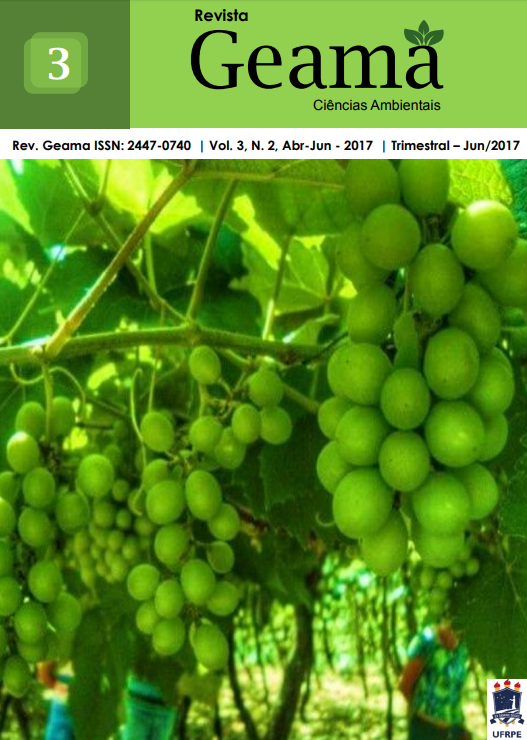Syagrus schizophylla: Unconventional Food Plant of the Caatinga Biome with a high caloric value | Syagrus schizophylla: Planta alimentícia não convencional do bioma de caatinga com alto valor calórico
Palavras-chave:
Catolé Coconut, Unconventional Plant Food, Nutritional ValueResumo
In the present day world concern relates to the effects of climate on plantations. In various parts of the world, forests, fields, plantations continue to disappear or are degraded. Brazil is a country that concentrates a great diversity of plants, this also refers to the Caatinga biome that participates in the vegetal cover of the state of Pernambuco, where this vegetation still displays the presence of unconventional food plants (UFP). Seeking to know in more detail the nutritional value of fruits of the palm Syagrus schizophylla known as Catolé coconut, this study sought to assess the centesimal composition of its almonds. Physico-chemical tests were performed in triplicate and according to methodologies of Instituto Adolfo Lutz-IAL. Before the results, it is concluded that the Catolé coconut almond is very nutritious and presents high caloric value.Downloads
Referências
AGEA, J.G.; KIMONDO, J.M.; WOISO, D.A.; OKIA, C.A.; OBAA, B.B.; ISUBIKALU, P.; OKULLO, J.B.L.; OBUA, J.; TEKLEHAIMANOT, Z. Proximate composition, Vitamin C and Beta-Carotene contents of fifteen selected leafy wild and semi-wild food plants (WSWFPs) from Bunyoro-Kitara Kingdom, Uganda. J. Nat. Prod. Plant Resour. v.4, n.3, p.1-12, 2014.
BRASIL. Ministerio do Meio Ambiente. Caatinga. 2017. Disponível em: http://www.mma.gov.br/biomas/caatinga. Acesso: 03.04.2017.
CASTRO, J. 1908-1973.Geografia da fome: o dilema brasileiro: pão ou aço Josué de Castro. Rio de Janeiro: Edições Antares, 1984. Disponível em: http://www.zorraquino.com.br/textos/eco-social/geografia-da-fome-josue-decastro.pdf. Acesso: 02.03.2017.
FERREIRA, A.P.P. Composição da comunidade de palmeiras (arecaceae) e remoção de frutos de Attalea attaleoides (BARB. RODR.) WESS.BOER E Astrocaryum gynacanthum MART. em uma floresta de terra-firme na amazônia central. Dissertação. Mestrado em Diversidade Biológica. Universidade Federal do Amazonas. 2011. 92p.
FRANCO, G. Tabela de Composição Química de Alimentos. São Paulo: Atheneu. 2002.
GIULIETTI, A.M.; BOCAGE NETA, A.L.; CASTRO, A.A.J.F; GAMARRA-ROJAS, C.F.L.; SAMPAIO, E.V.S.B.; VIRGINIO, J.F.; QUEIROZ, L.P.; FIGUEIREDO, M.A.; RODAL, M.J.N.; BARBOSA, M.R.V.; HARLEY, R.M. Diagnóstico da vegetação nativa do bioma Caatinga. Disponivel em http://s3.amazonaws.com/academia.edu.documents/35796376/Biodiversidade_Caatinga_parte2.pdf?AWSAccessKeyId=AKIAIWOWYYGZ2Y53UL3A&Expires=1497734862&Signature=UL1YnNzktkm1ynsD%2BclXvhwmBIQ%3D&response-content-disposition=inline%3B%20filename%3DDiagnostico_da_vegetacao_nativa_do_bioma.pdf, Acesso:05.03.2017.
IAL.Instituto Adolfo Lutz (São Paulo). Métodos físico-químicos para análise de alimentos/coordenadores Odair Zenebon, Neus Sadocco Pascuet e Paulo Tiglea -- São Paulo: Instituto Adolfo Lutz, 2008, 1020p. Disponivel em: http://wp.ufpel.edu.br/nutricaobromatologia/files/2013/07/NormasADOLFOLUTZ.pdf. Aceso: 24.04.2017.
IBGE. Instituto Brasileiro de Geografia e Estatística (IBGE – 2015). Disponível em: http://cidades.ibge.gov.br/xtras/temas.php?lang=&codmun=260030&idtema=159&search=pernambuco|agrestina|pecuaria-2015. Acesso em 11 de novembro de 2016.
KINUPP, V.F.; LORENZI, H. Plantas Alimentícias Não Convencionais (PANC) no Brasil: guia de identificação, aspectos nutricionais e receitas ilustradas. São Paulo: Instututo Plantarum de Estudos da Flora, 2014.
LORENZI, H., SOUZA, H.M., MADEIROS-COSTA, J.T., CERQUEIRA, L.S.C.; FERREIRA, E. 2004. Palmeiras Brasileiras e Exóticas Cultivadas. São Paulo: Instituto Plantarum, 2004. Páginas: 416p.
MARTINELLI, G.; MESSINA, T.; SANTOS FILHO. L. Livro Vermelho da Flora do Brasil: Plantas Raras do Cerrado. 1. ed. - Rio de Janeiro: Andrea Jakobsson : Instituto de Pesquisas Jardim Botânico do Rio de Janeiro : CNCFlora, 2014, 320 p.
MILLER Jr., G.T. Ciência Ambiental. São Paulo: Cengage Learning, 2014, 123p.
PAASONEN, P.; ASMI, A.; PETÄJÄ,T.; KAJOS, M.K.; ÄIJÄLÄ, M.; JUNNINEN, H.; HOLST, T.;ABBATT, J.P.D.; ARNETH, A.;BIRMILI, W.;VAN DER GON, H.D.; HAMED, A, András HOFFER, A.;LAAKSO, L.;LAAKSONEN, A.; LEAITCH, W. R.; PLASS-DÜLMER,C.; PRYOR, S. C.; RÄISÄNEN, P.; SWIETLICKI, E.; WIEDENSOHLER, A.; WORSNOP,D.R.; KERMINEN, V-M.; KULMALA, M. Warming-induced increase in aerosol number concentration likely to moderate climate change. Nature Geoscience. v.6, p.438–442, 2013.
PADILHA, M.R.F; SANTOS, M.C.G.; MATSUMOTO, M.; SHINOHARA, N.K.S.; MELO-FILHO, A.B. Palma Forrageira(Opuntis cochenillifera): Reinvenção Gastronômica. Nutrição em pauta (on line). v.4, n. 23, 2014.
SILVA, J.G.; PERELLÓ, L.F.C. Conservação de espécies ameaçadas do Rio Grande do Sul através de seu uso no Paisagismo. REVSBAU, Piracicaba – SP. v.5, n.4, p.01-21, 2010.
Downloads
Publicado
Como Citar
Edição
Seção
Licença
As Políticas Culturais em Revista aplica a Licença Creative Commons Atribuição-Não Comercial 4.0 Internacional (CC BY-NC-SA 4.0) para os trabalhos que publica. Esta licença foi desenvolvida para facilitar o acesso aberto - ou seja, o acesso livre, imediato, e a reutilização irrestrita de trabalhos originais de todos os tipos. Nossos autores mantêm os direitos autorais mas, sob essa licença, concordam em deixar os artigos legalmente disponíveis para reutilização, sem necessidade de permissão ou taxas, para praticamente qualquer finalidade. Qualquer pessoa pode copiar, distribuir ou reutilizar esses artigos, desde que o autor e a fonte original (Políticas Culturais em Revista) sejam devidamente citados.
![]()






